Posted by Elena del Valle on June 27, 2008

Happy for No Reason book cover
Photo: Marci Shimoff
Since she was a young girl Marci Shimoff has been trying to understand happiness. As an adult with an established national reputation as a speaker and author she decided to pursue this quest by asking the 100 happiest people she could find about their lives. From their responses and her research on the subject she and her co-author Carol Kline, outlined a seven-step process she shares with readers in Happy for No Reason 7 Steps to Being Happy from the Inside Out (Free Press, $24.95).
The 320-page hardcover self-help book was published in early 2008 and immediately began selling at a brisk pace. In the book, divided into three parts, she discusses happiness and how readers can develop seven happiness habits that may lead eventually to enhanced feelings of well being. Each chapter includes one case study from the Happy 100 individuals, some of them celebrities, Shimoff interviewed.
Her suggestions include looking after body, soul and relationships and working toward higher goals beyond an individual’s well being. She emphasizes that money alone doesn’t make people happy.
In Part I, Happiness That’s Here to Stay, there is an introduction and two chapters, Happy for No Reason… Really? and Practicing Happiness. Part II, Building Your Home for Happiness, is chapters 3 to 9 in which she describes developing happiness habits in: The Foundation, Take Ownership of Your Happiness; The Pillar of the Mind, Don’t Believe Everything You Think; The Pillar of the Heart, Let Love Lead; The Pillar of the Body, Make Your Cells Happy; The Pillar of the Soul, Plug Yourself In to Spirit; The Roof, Live a Life Inspired by Purpose; and The Garden, Cultivate Nourishing Relationships.
Part III, Happy for No Reason Ever After, includes the final chapter, The Happy for No Reason Plan for Life, as well as Recommended Resources, Acknowledgments, Giving Back and bios of the authors and the Happy 100.
Shimoff, one of the authors of the Chicken Soup for the Soul, authored six titles in the series, including Chicken Soup for the Woman’s Soul and Chicken Soup for the Mother’s Soul. According to promotional materials, those books have sold more than 13 million copies worldwide in 33 languages and have been on The New York Times bestseller list for 108 weeks.

Click here to buy Happy for No Reason
Comments:
Filed Under: Books
Posted by Elena del Valle on June 26, 2008

Downtown Orlando
Photo, charts: Orlando/Orange County Convention & Visitors Bureau, Metro Orlando Economic Development Commission
Partly because of Miami’s world renown as a Latino hub, and partly due to Orlando’s image as theme park destination, that central Florida city is often overlooked by marketers targeting Latino consumers. About 500,000 Latinos live in the Orlando, Daytona Beach and Melbourne area, representing about 21 percent of the market, according to the Metro Orlando Economic Development Commission. Some are starting to take notice of this area’s diverse population.
As traditional media targeting mainstream audiences continue to slash staff in a seemingly never ending quest to survive, Orlando media, realizing almost a quarter of their audience is Hispanic, are beginning to pay attention to the growing demographic, reflecting a national trend.
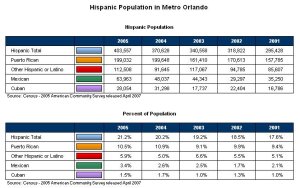
Hispanic Population in Metro Orlando – click on image to enlarge
From a media perspective, the metropolitan area ranks 19 in the Neilsen Media Research Designated Television Market Area (TV DMA) and 34 in the Radio Metro lists. In 2007, Entravision Communications bought an FM station, WNUE, marking the eleventh urban area where the company owns radio and television stations. Santa Monica based Entravision owns WVEN, the local Univision affiliate and operates WOTF, the Telefutra station, providing Spanish speakers in the area more than one viewing option.
WNUE’s popularity is starting to show. Last fall, the station tied with WRUM-FM, the Clear Channel station, for top Spanish station. It’s no wonder with half of the state’s 750,000 Puerto Ricans living near Disney, according to an online source. After Puerto Ricans, Latinos of Mexican, Colombian and Dominican origin are the most common.
Target Latinos effectively by anticipating changes in the market with
“Hispanic Projections with 2007-08 update” audio recording

Presenter Roger Selbert, Ph.D.
Find out
- About Latino buying power growth in the future
- How Latino market growth compares with other markets in the U.S.
- What drives the rise of Latino economic clout
- Who should target the Latino market
- What is the size of the Hispanic affluent market
- If the luxury Latino market is growing
Stay ahead of your competition with “Hispanic Projections”
According to a 2007 report by Fishkind & Associates, Inc., Central Florida’s Latino population is growing at a faster pace than other segments of the population. The researchers project the Hispanic community will grow at a rate 2 to 4 percent higher than non-Hispanics by the end of the decade.
The researchers also believe that 41 percent of Osceola County’s population will have Hispanic roots by 2009. At the same time, over the past seven years personal income for the area’s Hispanics rose 64 percent and is projected to increase an additional 12 percent by 2010 to reach $10.5 billion or more.
Fishkind & Associates is an Orlando economic consulting firm that conducts market and demographic research. The 2007 findings were part of the company’s second dedicated Hispanic market study. A non profit, private/public partnership, the Economic Development Commission serves Orange, Seminole, Lake and Osceola counties and the City of Orlando. The organization staff try to attract new business investment and work with local companies to facilitate expansion plans.
Find out which Latino markets are booming with
“The Next Step: Secondary Latino Markets” audio recording

Presenter Dora O. Tovar, MPA
Click here for information on Secondary Latino Markets
Posted by Elena del Valle on June 25, 2008
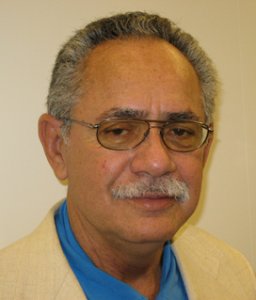
Rodolfo de la Garza, project director
Photo: Rodolfo de la Garza
According to a recently released study,”African American and Latino Enrollment Trends among Medicine, Law, Business, and Public Affairs Graduate Programs,” funded by the Ford Foundation and conducted by researchers from the Tomás Rivera Policy Institute (TRPI), few Latino and African American students are enrolling in medicine, law, business, and public affairs graduate programs. This is due in part to a low number of high school graduates among these ethnic groups and the bachelor’s degree entry requirement of the programs. Affirmative action and law suits related to affirmative action have also been contributors, according to the report.
The report was prepared by Rodolfo de la Garza, project director, and Sepehr Hejazi Moghadam, research associate, of the Tomas Rivera Policy Institute office at Columbia University. The researchers selected disciplines “where policy makers go and come from” and those they believe most influence the nation. They approached the top 10 public and private schools and programs in each category to request interviews and information. The study took place over an 18 month period beginning in 2006.
“Many of the universities wouldn’t respond or said they don’t provide that kind of study,” said de la Garza about how the universities reacted to project. “Ford gave a rather handsome grant of more than $15,000.”
Target Latinos effectively by anticipating changes in the market with
“Hispanic Projections with 2007-08 update” audio recording

Presenter Roger Selbert, Ph.D.
Find out
- About Latino buying power growth in the future
- How Latino market growth compares with other markets in the U.S.
- What drives the rise of Latino economic clout
- Who should target the Latino market
- What is the size of the Hispanic affluent market
- If the luxury Latino market is growing
Stay ahead of your competion with “Hispanic Projections”
The researchers believe the elimination of affirmative action has decreased the number of underrepresented students enrolling in medical schools. Based on the data they were able to gather, African American applicants who applied to the top 10 public and private medical schools declined by 25 percent from 5,379 in 1995 to 4,033 in 2001. Latino applicants to the same schools decreased 38.6 percent, from 2,769 in 1995 to 1,700 in 2001. Together, African American and Latino enrollment in the nation’s top 10 public and private medical schools declined by 11.2 percent and 27 percent respectively.
As an example of the drop in law school registrations because of California’s anti-affirmative action movement the report points to California law schools. From fall 1995 to fall 2006, the number of admitted African American and Latino students in University of California’s three law schools declined 28 percent.
While there was an increase in undergraduate business degrees awarded to African American and Latino students over the past nine years, these degrees rose from 9 percent of total degrees in the country between 1995 and 1996, to 15 percent between 2003 and 2004; the researchers point out that the growth in enrollment does not match the growth of the African American and Latino markets, currently 25 percent. There are more African Americans and Latinos graduating with MBA degrees than other master’s degrees and this number once again do not reflect the growth of the African American and Latino populations in the United States.
On the good news front, more diverse students are graduating with public affairs master’s degrees which train students for careers in government, business, media, nonprofit organizations, non governmental and international organizations. Master’s degrees in traditionally underrepresented groups have increased from 18 percent in 1996 to 25 percent in 2004. Once again the increase is inconsistent with the growth of the African American and Latino populations nationwide.
Founded in 1985, the Tomás Rivera Policy Institute (TRPI) advances informed policy on key issues affecting Latino communities through objective and timely research contributing to the betterment of the nation. TRPI is an affiliated research unit of the University of Southern California School of Policy, Planning, and Development and is associated with the Institute for Social and Economic Research and Policy at Columbia University.
Find out which Latino markets are booming with
“The Next Step: Secondary Latino Markets” audio recording

Presenter Dora O. Tovar, MPA
Click here for information on Secondary Latino Markets
Posted by Elena del Valle on June 24, 2008

Casio Spanish language ad
Photos: Revolucion NYC
Casio executives recently decided to introduce one of their products to Spanish speaking Latinos in the United States for the first time. Revolucion NYC won the account with an ad campaign touting the benefits of the EXILIM EX-S10, a thin digital camera, and recruiting television celebrity Lili Estefan, known by her nickname La Flaca, as spokesperson.
“Why don’t we have La Flaca selling another flaca,” said Amy Gomez, managing partner and director, Account Services at Revolucion NYC about the brainstorming session where the campaign was born. “Two weeks after that thought we were shooting in Miami.”

Amy Gomez, managing partner and director, Account Services at Revolucion NYC
To begin, Casio staff selected two markets, Houston and Los Angeles, to launch the campaign which began running May 6 and will conclude in early July 2008. The two-pronged campaign is appearing on 30-sheet billboards in Houston and 8-sheet billboards in Los Angeles and online.
Spanish speaking residents of Los Angeles and Houston who see the banner ads are driven to a microsite created by the agency. Consumers are invited to purchase the camera at retail stores, especially through Best Buy and La Curacao, two program partners.

Casio Spanish language ad – click on image to enlarge
According to Gomez, after trying out the camera for the first few days, Estefan was so enthusiastic she requested 15 more cameras to give as gifts to her friends, and volunteered eagerly to assist in the public relations efforts for the camera.
Make your ads resonate with Hispanics
Listen to C&R’s Research Director Liria Barbosa in
“Hispanics’ Perspective on Advertising” audio recording

Liria Barbosa gives a presentation and participates in an extended Q&A discussion about
• Type of ads Latinos prefer
• Latino top media choices
• Percent of Latinos who tried products because of ads
• Percent of Latinos who purchased products because of ads
• What makes an ad “Hispanic”
• If ad language is important for bicultural Latinos
• What to keep in mind when targeting bicultural Latinos with ads
Click here for information on Hispanic Perspectives on Advertising
The agency produced seven different ads, each one boasting about a different feature, according to Roberto Alcazar, executive creative officer at Revolucion NYC. It took three creative team members two months from beginning to end to create and develop the ads. The team members were Alcazar, Josefina Fuster, and Alberto Rodriguez. The photos were taken at Kikor Studio in Miami.
“Revolucion presented us with an integrated, turnkey approach to bring this unique product to the market,” said Sue VanderSchans, director of Strategic Communications and Marketing, Casio America.
Plans are to add Miami and one additional market and restart the campaign in October 2008 in time for the holiday season. The camera sells for $249.99 and is 3.71 inches wide by 2.15 inches tall and .59 inches thick. At its thinnest it is 0.54 thick, giving rise, according to Gomez, to the camera’s Spanish language nickname of la flaca. The weight, excluding battery and accessories, is 3.99 ounces.
Revolucion Hispanic Communications is a seven year old Hispanic-owned brand-communications agency based in New York City. The Japan based Casio Computer Company Ltd. was founded in 1957 and has 13,202 employees.
“Moving Beyond Traditional Media Measurement: measuring conversations and social media” audio recording

Presenter Katie Delahaye Paine, founder, KDPaine & Partners
Find out about
- Issues affecting online public relationships today
- Testing relationships as part of a survey
- Measuring ethnic group relationships
- Measuring foreign language communications in a similar ways to English
- Biggest challenges measuring conversations and social media
- Measuring online relationships with little or no money
Click here for information on “Moving Beyond Traditional Media Measurement”
Posted by Elena del Valle on June 23, 2008

Heather Dominick, owner, EnergyRich Coaching, Inc.
Photo: Heather Dominick
A podcast interview with Heather Dominick, owner, EnergyRich Coaching, Inc. is available in the Podcast Section of Hispanic Marketing & Public Relations, HispanicMPR.com. During the podcast, Heather discusses how to use your energy to attract clients and customers with Elena del Valle, host of the HispanicMPR.com podcast.
Heather is the creator of the EnergyRich Success System for Entrepreneurs: the essence of her years of education, energy and intuitive training, as well as marketing and sales tools. Heather uses this step-by-step system to coach women entrepreneurs by creating an energetic map to harness their energy. Her coaching philosophy is that an individual cannot do business, but needs to be business at a holistic level that integrates thoughts, feelings, words, and actions. She calls this managing your energy.
She believes it’s important that an entrepreneur do the inner and outer work necessary to activate this skill. Only when the entrepreneur has activated this skill internally can he or she fully and confidently present their business to others and the world.
A national speaker, Heather has inspired hundreds of women to build enough self-belief to achieve what seems to be impossible. She delivers keynote addresses and seminars on spiritual business practices to organizations and associations and consistently receives feedback about how her presentations amplify the audience energy levels and move them into action. She has presented for numerous organizations, including Con Edison, Transformation U, The Chopra Center, Pace University, and various coaching associations.
Heather has been interviewed by media publications and her writings have appeared on websites and in magazines, including WorkingWomen.com and For Her Information. She has more than 11 years of teaching and coaching experience in helping women entrepreneurs develop an authentic, energy-minded business simultaneously structured for more daily joy, service and bottom line profits.
To listen to the interview, scroll down until you see “Podcast” on the right hand side, then select “HMPR Heather Dominick,” click on the play button below or download the MP3 file to your iPod or MP3 player to listen on the go, in your car or at home. To download it, click on the arrow of the recording you wish to copy and save to disk. The podcast will remain listed in the June 2008 section of the podcast archive.
“How to Use Your Energy to Attract Clients and Customers” audio recording

Presenter Heather Dominick, owner, EnergyRich Coaching, Inc.
A 106-minute audio recording including a presentation by Heather and the complete interview with Heather where she discusses:
- Heather’s step by step system for women entrepreneurs
- Her coaching philosophy that an individual needs to be business at a holistic level
- Core beliefs about creating magnificent marketing for your business
- How Heather transitioned from a high school drama teacher to a coach
- The three Os that characterized her life at the time
- Heather’s first steps to changing her life
Click here for information on How to Use Your Energy to Attract Clients and Customers
Ready to buy? Select a format to add to your shopping cart:
Downloadable “ How to Use Your Energy to Attract Clients and Customers ” MP3 $119.95
Audio CD’s “How to Use Your Energy to Attract Clients and Customers ” $139.95
Posted by Elena del Valle on June 20, 2008
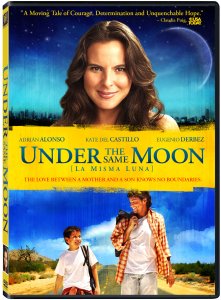
Under the Same Moon DVD cover
Photo, video: Twentieth Century Fox Home Entertainment
On June 17, 2008 Fox Entertainment released Under The Same Moon (La Misma Luna) on DVD, a story about the journey of a boy from Mexico to the United States to find his mother. The 106-minute film in English and Spanish, a 2007 Sundance Film Festival Crowd Pleaser, was first released in the United States in October 2007 and again in March 2008. The DVD sells for $29.98. Scroll down to watch video trailers of Under the Same Moon.
The film stars Adrian Alonso (The Legend of Zorro), Kate del Castillo (El Derecho de nacer) and Eugenio Derbez, (Los Perplejos), Jesse Garcia (The Comebacks), Carmen Salinas (Man on Fire) and America Ferrara (Ugly Betty) in a PG13 film from first-time director Patricia Riggen.
Under The Same Moon portrays the parallel stories of nine-year-old Carlitos (Alonso) and his mother, Rosario (Del Castillo). Hoping to make a better life for her and her son, Rosario works illegally in the U.S. while her mother cares for Carlitos in Mexico. Unexpected circumstances drive Rosario and Carlitos to embark on their own journeys in an attempt to reunite. Along the way, mother and son face challenges and obstacles while maintaining the hope of being together again.
Make your ads resonate with Hispanics
Listen to C&R’s Research Director Liria Barbosa in
“Hispanics’ Perspective on Advertising” audio recording

Liria Barbosa gives a presentation and participates in an extended Q&A discussion about
• Type of ads Latinos prefer
• Latino top media choices
• Percent of Latinos who tried products because of ads
• Percent of Latinos who purchased products because of ads
• What makes an ad “Hispanic”
• If ad language is important for bicultural Latinos
• What to keep in mind when targeting bicultural Latinos with ads
Click here for information on Hispanic Perspectives on Advertising
Under The Same Moon is presented in widescreen format with English, French and Spanish subtitles, and includes commentary, deleted scenes and two featurettes. Bonus content includes The Murals of Under the Same Moon Featurette and The Making of La Misma Luna Featurettes.
Twentieth Century Fox Home Entertainment LLC is the marketing, sales and distribution company for Fox film and television programming on DVD, Blu-ray Disc (BD) and Digital Copy as well as acquisitions and original productions. The company also releases all products around the globe for MGM Home Entertainment. Twentieth Century Fox Home Entertainment LLC is a subsidiary of Twentieth Century Fox Film News Corporation, a News Corporation company.
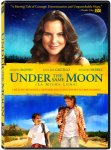
Click here to buy Under the Same Moon
Posted by Elena del Valle on June 19, 2008

An artist rendering of Tacos & Tequila – click on image to enlarge
Photos: Luxor Hotel and Casino
The Luxor Hotel and Casino in Las Vegas, Nevada is planning to open a new 8,000 square foot restaurant with a modern look and Mexican style menu this summer. Michael Frey, the driving force behind the project, recruited Chef Richard Sandoval and Designer Adam Tihany to make the project come alive. It will be the first project of his new company, Drive This Entertainment!
“This is not your grandma’s cantina; think Pink Taco meets Coyote Ugly interpreted by Quentin Tarantino,” said Frey. “I am excited to bring our version of a sexy, energy infused Mexican restaurant to life. Offering more than just a great place to grab an amazing taco or great tequila, it will be a dining experience that will tantalize the senses.”
“Best in Class Hispanic Strategies” audio recording


Presenters Carlos Santiago and Derene Allen
-
Find out what makes 25 percent of the top 500 Hispanic market advertisers out perform the remaining companies
-
Discover what questions to ask, steps to take to be a Best in Class company
Click here for more about “Best in Class Hispanic Strategies” audio recording
To bring his edgy vision to life, Frey partnered with friend Tihany and Alvarez + Brock Design, a New York-based hospitality design firm. They were inspired by what they believe are five essential elements of Mexican culture: the sombrero, the shot glass, the bullfight, skeletons and seductive women.
The target audience? Anyone who likes tacos and tequila, according to a company spokesperson. On the marketing side, plans are in place to position Tacos & Tequila, referred to as T&T in promotional materials, as the newly favored Mexican restaurant on The Strip through an aggressive public relations campaign; and “focusing on building brand awareness throughout the Las Vegas valley and feeder markets, garnering key TV and print media placements, as well as through grassroots efforts aimed at creating a buzz that drives traffic to the restaurant.”

An artist rendering of Tacos & Tequila – click on image to enlarge
On the food side of things Sandoval will be consulting chef. The menu is expected to include a juxtaposition of modern and traditional Mexican cuisine as well as an extensive list of tequilas specialty cocktails and infused tequilas. In addition to serving lunch and dinner, promoters hope T&T’s El Salon will become a popular nightlife spot. It will be open from11 a.m. to 11 p.m. and offer late-night dining from the taco bar until 3 a.m.
The designers plan a massive brushed aluminum ceiling to pay tribute to the sombrero. There will also be two 20-foot laser cutouts of dancing skeletons and the cover will be lined with lights that shoot down to the ground reflecting the skeleton images on the concrete floor.
Chair coverings and decorative lighting will be in hues of yellow, red, green, orange and blue. The bar will resemble a bull-fighting arena. Seated on stadium-style shelves, the liquor bottles will be arranged like spectators overlooking a fierce bullfight, painted as a large mural below while rock ‘n‘ roll music plays in the background.
Plans call for a freestanding frozen daiquiri bar selling drinks to guests on the go and a clothing and souvenir shop. The boutique will specialize in men’s and women’s shirts, women’s logo-embroidered jean shorts and capris with the signature “T” on the back pocket.
“Segmentation by Level of Acculturation” audio recording

Presenter Miguel Gomez Winebrenner
Discusses
- Assimilation versus acculturation
- Factors that affect Latino acculturation
- How to know if someone is acculturated
- Number of years necessary for acculturation
- Effects of immigration debate on acculturation
- Three main ways of segmenting Latinos
Click here for details about “Segmentation by Level of Acculturation”
Posted by Elena del Valle on June 18, 2008
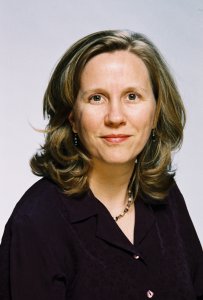
Jena Atchison, manager Segment Marketing, Southwest Airlines
Photo, video: Southwest Airlines
Southwest Airlines marketing executives hope to win new customers from among Spanish speaking Latinos in the United States with Relax!, a newly launched Spanish language television campaign scheduled to air from early June until the fall season 2008. In the past10 ten years, the company has released eight Spanish language ad campaigns with the help of its agency. Scroll down to watch two of the Southwest Airlines Relax! ads in Spanish.
The Relax! commercials, designed to promote hassle free travel, will run on Univision, Telemundo, and Azteca networks. The title Relax! was designed to show prospective customers that Southwest understands the difficulties travelers may have before a vacation and how the airline can provide “a better environment so that customers can start a great relaxing journey.” The campaign was created by Dieste, Harmel and Partners.
The Relax! ads were shot in various locations over two days in Mexico City. Although airline representatives do not have data on the number of Hispanic customers they serve, they are evaluating metrics to allow them to determine those numbers in the future. In 2007, Southwest spent almost 18 million on Spanish language television ads, slightly more than the previous year according to Nielsen Monitor-Plus.
“Best in Class Hispanic Strategies” audio recording


Presenters Carlos Santiago and Derene Allen
-
Find out what makes 25 percent of the top 500 Hispanic market advertisers out perform the remaining companies
-
Discover what questions to ask, steps to take to be a Best in Class company
Click here for more about “Best in Class Hispanic Strategies” audio recording
The company has launched Spanish language campaigns in the past to promote low fares and affordability. Marketers hope the new campaign will position Southwest among Hispanics as an approachable airline that understands and respects them. The company wants to let Hispanic customers know that employees do “whatever it takes to provide them with friendly service and a pleasant experience.”
“At Southwest Airlines we believe in giving our customers the freedom to fly, access to low fares, and excellent service. Our campaign demonstrates the accessibility of our airline with a clear message of hassle-free travel,” said Jena Atchison, manager Segment Marketing for Southwest Airlines.
Dallas based Southwest Airlines serves 64 cities in 32 states. Southwest operates more than 3,400 flights a day and has more than 33,000 employees system wide. Southwest boasts of premium all leather seats and extra legroom with a young, all-Boeing 737 fleet. According to promotional materials, Southwest is fee averse; the airline has no first or second checked bag fees, no change fees, no fuel surcharges, no snacks fees, no aisle or window seat fees, no curbside check-in fees, and no phone reservations fees.
Hispanic Marketing and Public Relations Understanding and Targeting America’s Largest Minority book

“A must resource for practitioners/professionals expecting to reach US Hispanics; also valuable for college programs in marketing, public relations and communications. Highly recommended.”
Choice magazine
Click here for information on the Hispanic Marketing & Public Relations books
Posted by Elena del Valle on June 17, 2008

A scene from Gabriel in Venice
Photos: WSBS
Spanish Broadcasting System, Inc. will release Gabriel, its first mini series, in September 2008. Filmed in Miami, Venice and Puerto Rico, Gabriel is 12 hours long and will be broadcast in10 episodes. DirecTV Más will co-produce the project which was filmed in high-definition with 3-D animation.
Two well known personalities will be part of the series, Chayanne and José Luis Rodríguez “El Puma.” Chayanne plays Gabriel, a modern-day vampire in the network’s first miniseries produced by Megafilms, the company’s new entertainment division. Rodriguez plays Pizarro, another vampire.

Mexican actor Angelica Celaya as Eva
The female lead is played by Mexican actor Angelica Celaya as Eva. In Gabriel, Eva is a beautiful and dedicated nurse who works at an Emergency Room. A direct bloodline descendant of Gabriel’s former wife, Eva is the reincarnation of Gabriel’s lost love. Her mysterious nightly dreams about her ancestry are heightened when Gabriel appears in her life.
Make your ads resonate with Hispanics
Listen to C&R’s Research Director Liria Barbosa in
“Hispanics’ Perspective on Advertising” audio recording

Liria Barbosa gives a presentation and participates in an extended Q&A discussion about
• Type of ads Latinos prefer
• Latino top media choices
• Percent of Latinos who tried products because of ads
• Percent of Latinos who purchased products because of ads
• What makes an ad “Hispanic”
• If ad language is important for bicultural Latinos
• What to keep in mind when targeting bicultural Latinos with ads
Click here for information on Hispanic Perspectives on Advertising
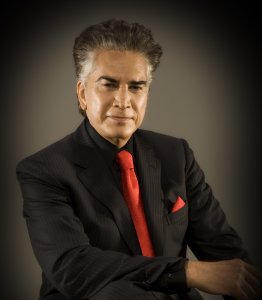
José Luis Rodríguez “El Puma”
Laura Ferretti plays Maribel Delgado, Eva’s best friend and roommate. Maribel studies psychology and works nights as a waitress at a bar in Miami Beach to pay for her college tuition. In her spare time she studies the tarot cards and explores the occult.
Sebastián Ligarde, a Mexican actor, is Santori, a religious investigator and fanatic commissioned by the Vatican to destroy the bloodthirsty Pizarro. Additional cast members include Julián Gil, Laura Zerra, Freddy Viquez, Juan David Ferrer, Alvaro Ruiz, Marcos Miranda, Leonard Krys and Camila Banus.
Megafilms, a wholly-owned subsidiary of SBS, was created in 2008 to produce Spanish-language full-length features, miniseries, telenovelas, documentaries and filmed entertainment for domestic and international distribution.
Spanish Broadcasting System, Inc. is one of the largest publicly traded Hispanic-controlled media and entertainment companies in the United States. SBS owns and operates 20 radio stations located in Hispanic markets such as New York, Los Angeles, Miami, Chicago, San Francisco and Puerto Rico. The Company also owns and operates Mega TV in Miami.
Listen to Cesar Melgoza discuss
“Changing Latino Landscape” audio recording

Presenter Cesar Melgoza, managing director, Latin Force Group
Find out about
• How demographic, social, political and economic factors affect Latinos
• Number of Hispanics in U.S.
• Hispanics as a percent of the mainstream population
• Number of Puerto Ricans in Puerto Rico
• Hispanics, including Puerto Rico, as a percent of U.S. mainstream
• Number of Asians and African Americans
• Estimated size of Hispanic market by 2012
• Percentage growth of new Hispanics per year
• Number of counties where Latinos are majority
• Areas of significant Latino growth
• Area of U.S. with a 950 percent Latino growth
• Role of acculturation
• Hispanicity segmentation
Click here for information on the Changing Latino Landscape
Posted by Elena del Valle on June 16, 2008

Alberto Oliva, editor-in-chief, Ser Padres
Photo: Meredith Corporation
A podcast interview with Alberto Oliva, editor-in-chief, Ser Padres is available in the Podcast Section of Hispanic Marketing & Public Relations, HispanicMPR.com. During the podcast, he discusses the magazine with Elena del Valle, host of the HispanicMPR.com podcast.
Alberto joined Meredith Corporation, the parent company of Ser Padres, in October 2001 bringing more than 30 years of experience with Hispanic media as an editor, journalist and author. Ser Padres is Meredith’s parenting magazine for Hispanics launched in the fall of 1990 and one of the largest Spanish-language consumer magazines in the United States.
Prior to joining Ser Padres, Alberto was associate editor for People en Español from 1998-2001, U.S. bureau chief for Editorial Atlantida from 1984 to 1998 where he first began his career in 1970 as a journalist. During this time he also served as a reporter and journalist for the Associated Press in New York from 1976-1978.
Make your ads resonate with Hispanics
Listen to C&R’s Research Director Liria Barbosa in
“Hispanics’ Perspective on Advertising” audio recording

Liria Barbosa gives a presentation and participates in an extended Q&A discussion about
• Type of ads Latinos prefer
• Latino top media choices
• Percent of Latinos who tried products because of ads
• Percent of Latinos who purchased products because of ads
• What makes an ad “Hispanic”
• If ad language is important for bicultural Latinos
• What to keep in mind when targeting bicultural Latinos with ads
Click here for information on Hispanic Perspectives on Advertising
Alberto authored two books, Magazines that Make History published August 2004, and In Vogue, A visual history of the most influential fashion magazine in the world published October, 2006. He has a master’s degree in Communications from the Instituto Nacional del Profesorado in Buenos Aires, Argentina.
A resident of New York City, he has been a visiting professor at the University of Salamanca in Spain from 2005 to 2008, at Stanford University in California from 2005 to 2007, and at New York University in New York in 2006. He is fluent in Spanish, French, Italian and Portuguese.
To listen to the interview, scroll down until you see “Podcast” on the right hand side, then select “HMPR Alberto Oliva” click on the play button or download it to your iPod or MP3 player to listen on the go, in your car or at home. You can also subscribe to the podcast by right clicking over the podcast box and selecting “copy shortcut” then inserting the URL address in the podcast section of your iTunes program listed under the “advanced” column. The podcast will remain listed in the June 2008 section of the podcast.
“Best in Class Hispanic Strategies” audio recording


Presenters Carlos Santiago and Derene Allen
-
Find out what makes 25 percent of the top 500 Hispanic market advertisers out perform the remaining companies
-
Discover what questions to ask, steps to take to be a Best in Class company
Click here for more about “Best in Class Hispanic Strategies” audio recording





































